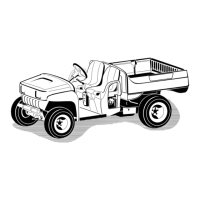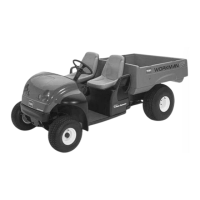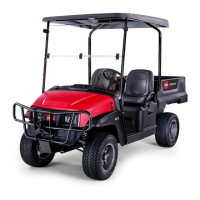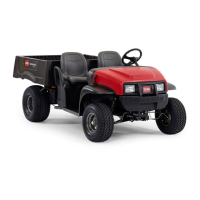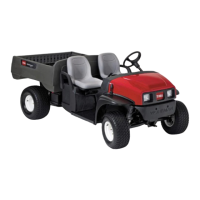as long to stop on w et surfaces as on dr y
surfaces . If y ou dri v e through standing w ater
dee p enough to g et the brak es w et, they will
not w ork w ell until they are dr y . After dri ving
through w ater , y ou should test the brak es to
mak e sure they w ork properly . If they do not,
dri v e slo wly while putting light pressure on the
brak e pedal. T his will dr y the brak es out.
Operating on Hills
Operating the v ehicle on a hill may cause
tipping or r olling of the v ehicle, or the engine
may stall and y ou could lose head w ay on the
hill. T his could r esult in per sonal injur y .
• Do not accelerate quickl y or slam on
the brak es when backing do wn a hill,
especiall y with a load.
• If the engine stalls or y ou lose head w ay
on a hill, slo wl y back straight do wn the
hill. Nev er attempt to tur n the v ehicle
ar ound.
• Operate the v ehicle slo wl y on a hill and
use caution.
• A v oid tur ning on a hill.
• R educe y our load and the speed of the
v ehicle.
• A v oid stopping on hills, especiall y with
a load.
T hese extra cautions need to be tak en when
operating the v ehicle on a hill:
• Slo w do wn before star ting up or do wn a hill.
• If the engine stalls or y ou begin to lose headw a y
while climbing a hill, g radually apply the brak es
and slo wly bac k straight do wn the hill.
• T ur ning while tra v eling up or do wn hills can
be dang erous . If y ou ha v e to tur n while on a
hill, do it slo wly and cautiously . Nev er mak e
shar p or fast tur ns .
• Hea vy loads affect stability . R educe the w eight
of the load and y our speed when operating on
hills or if the load has a high center of g ra vity .
Secure the load to prev ent it from shifting and
tak e extra care when hauling loads that shift
easily (liquid, roc k, sand, etc .).
• A v oid stopping on hills , especially with a load.
Stopping while g oing do wn a hill will tak e
long er than stopping on lev el g round. If the
v ehicle m ust be stopped, a v oid sudden speed
c hang es , whic h ma y initiate tipping or rolling
of the v ehicle . Do not slam on the brak es
when rolling bac kw ard, as this ma y cause the
v ehicle to o v er tur n.
• W e strongly recommend installing the optional
R OPS Kit when operating on hilly ter rain.
Operating on Rough Terrain
R educe speed and load when operating on rough
ter rain, unev en g round, and near curbs , holes , and
other sudden c hang es in ter rain. Loads ma y shift,
causing the v ehicle to become unstable .
W e strongly recommend installing the optional
R OPS Kit when operating on rough ter rain.
Sudden changes in ter rain may cause a br upt
steering wheel mo v ement, possibl y r esulting
in hand and ar m injuries.
• R educe y our speed when operating on
r ough ter rain and near curbs.
• Grip the steering wheel loosel y ar ound
the perimeter . K eep y our hands clear of
the steering wheel spok es.
Loading and Dumping
T he w eight and position of the carg o and
passeng er can c hang e the v ehicle center of g ra vity
and v ehicle handling . T o a v oid loss of control and
personal injur y , follo w these guidelines:
• Do not car r y loads whic h ex ceed the load
limits described on the v ehicle w eight label;
refer to Specifications in Product Ov er view ,
pag e 17 , for v ehicle w eight limits . T he load
rating is for lev el surf aces onl y .
• R educe the w eight of the load when operating
on hills and rough ter rain to a v oid tipping or
o v er tur ning of the v ehicle .
• R educe the w eight of the load if the center of
g ra vity is high. Items suc h as bric ks , fer tilizer ,
or landscape timbers stac k higher in the bo x.
T he higher a load is stac k ed, the more lik ely
6

